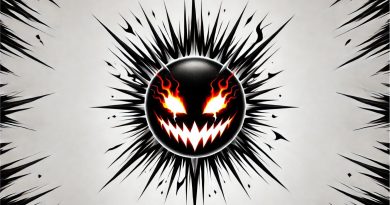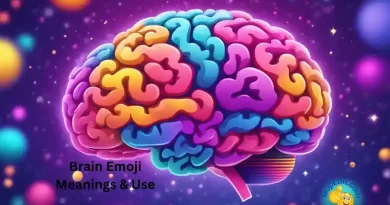Out of This World: Best Uses for the Alien Emoji
Uses for the alien emoji might seem like a quirky topic, but it’s surprisingly rich with insights.
In the vast universe of digital communication, emojis have become our universal language.
The alien emoji has developed a character of its own, transcending the boundaries of digital communication.
From signaling an out-of-this-world idea to playfully suggesting someone is not from this planet, understanding the best uses for the alien emoji can add some extraterrestrial fun to your chats!
Table of Contents:
- The Evolution of Emoji and Their Meanings
- Embracing Diversity in Emoji Representation
- Alien Invasion – The Mystery of Unrecognized Emoji
- Expanding Emoji Availability Across Platforms
- Decoding The Alien Emoji
- Emojis Beyond Faces – Exploring Objects And Symbols
- Navigating The Future Of Emojis
- FAQs in Relation to Uses for the Alien Emoji
- Conclusion
The Evolution of Emoji and Their Meanings
Emojis have become a staple in our digital communication, making conversations more vibrant and expressive.
From the simple smiley face to the intricate long nose face emoji, these tiny icons convey emotions that words sometimes fail to express.
A Journey Through Time: The Birth of Emojis
The inception of emojis can be traced back to Japan in 1999.
Shigetaka Kurita, an engineer at NTT Docomo, was inspired by weather forecasts using symbols and Chinese characters’ ability to encapsulate meaning succinctly.
Rise Of Standard Emoji Sets And Menus
In their early days, emojis were primarily used within specific platforms or devices.
This led many tech companies like Apple and Google to develop their own standard emoji sets for wider usage across different operating systems.
Suddenly users had access not just limited figures but also colorful heart emojis as well as cat emojis right from their standard emoji menus.
Towards A Universal Language: Unicode Consortium’s Role In Normalizing Emojis
To address compatibility issues between different platforms’ unique codesets, the Unicode Consortium stepped into normalize this burgeoning language. Unicode’s proposal in 2010, paved way for global standards ensuring your monster emoji looks consistent whether you’re on Android or iOS.
Different Faces For Different Tastes: Hilarious Misunderstandings & Unrecognized Emojis
However with diversity came confusion too.
For instance, did you know that what appears as a grey skull on some phones might show up completely differently elsewhere? Or how about when older versions of iOS would display unrecognized emojis like alien heads leading it being referred ‘alien invasion’?
Now imagine sending out a friendly message only for it turn into something bizarre due misunderstanding.
Stay tuned next we dive deeper exploring representation through diverse racial characters, LGBT pictograms, and much more.
Key Takeaway:
Emojis have evolved from simple smiley faces to expressive icons that convey emotions. They originated in Japan in 1999 and gained popularity across different platforms, leading to the development of standard emoji sets by tech companies like Apple and Google. The Unicode Consortium played a role in normalizing emojis globally. However, diverse interpretations and unrecognized emojis can lead to confusion. Stay tuned for more on representation through racial characters and LGBT pictograms.
Embracing Diversity in Emoji Representation
The world of emojis has evolved far beyond simple yellow faces and common objects. Thanks to the Unicode Consortium’s 2014 proposals, we now have a more inclusive range of characters at our fingertips.
Racially Diverse Characters: A Step Forward
In an effort to reflect real-world diversity, standard emoji sets have expanded their roster. The introduction of racially diverse characters is not just about variety; it’s about representation.
This development allows users across different cultures and ethnicities to express themselves authentically through single figure emojis with various skin tones. It’s no longer one-size-fits-all – you can choose an emoji that resonates with your identity.
LGBT Pictograms and Their Significance
Beyond racial inclusivity, there was also a push for representing sexual orientations within the standard emoji menu. Enter LGBT pictograms – these colorful additions are boosting visibility for non-heteronormative identities worldwide.
Celebrating love in all its forms, iOS introduced same-sex couple emojis as part of its commitment towards promoting equality via digital platforms. These cartoonish figures go beyond being cute icons on your keyboard, they’re powerful symbols advocating acceptance and respect among users globally.
Alien Invasion – The Mystery of Unrecognized Emoji
The world of emojis is vast and constantly evolving, but what happens when we encounter an unrecognized emoji?
In the realm of digital communication, this can lead to a phenomenon playfully referred to as ‘alien invasion’.
Decoding the Alien Invasion Phenomenon
This so-called alien invasion occurs when older versions of iOS come across unrecognized emojis in messages or social media posts.
Rather than displaying these characters as blank spaces or question marks, they are represented by grey alien heads on the standard emoji menu.
provides more insight into this peculiar occurrence.
The cause behind it? It’s simple: software updates.
Newer additions to our beloved sets might not be recognized by outdated systems hence leading them down an unexpected path towards “invasion”.
iOS vs Android – A Tale Of Two Platforms
Different platforms interpret unrecognized emoji differently due to their unique coding standards.
While Apple devices opt for an extraterrestrial substitution (cue tiny purple fist waving), Android faces have a different approach altogether.
If you’ve ever received a message containing unfamiliar icons from your friends using iPhones while you’re on android, now you know why.
This difference has sparked many conversations about compatibility issues among diverse users worldwide which led Unicode Consortium’s 2014 proposals aiming at universal recognition regardless device type used.
A step closer towards global harmony perhaps?
Navigating through myriad colorful heart shapes and long nose face figures may seem daunting initially yet once mastered becomes second nature.
We’ll explore next how expanding availability could potentially address limitations currently faced within group settings… Stay tuned.
Expanding Emoji Availability Across Platforms
In the world of digital communication, emojis have become a universal language. Their popularity has led to an expansion in their availability across various platforms.
Apple, for instance, took significant steps towards making new emojis accessible not just on mobile devices but also Mac desktops with updates like OS 10.10.3.
Potential Future Updates and Limitations
The continuous evolution of standard emoji sets is exciting to witness as it paves the way for more inclusive and diverse emoji representations such as racially diverse characters or LGBT pictograms.
However, there are still limitations that need addressing – particularly when it comes to group emojis which currently lack customization options compared to single figure emoji selections available on iOS devices due to Unicode Consortium’s 2014 proposals.
Cross-Platform Compatibility Challenges
A crucial aspect that developers grapple with is ensuring cross-platform compatibility so that an alien invasion doesn’t occur – referring here humorously yet accurately about how older versions of iOS display unrecognized emojis as grey alien heads.
This challenge extends beyond facial expressions and humanoid figures into object-based symbols like the tiny purple fist or colorful heart emoji where different software standards may cause them appear differently between Android faces versus IOS’s space invaders-esque appearance.
The Role Of Unicode In Standardizing Emojis
To tackle these challenges head-on, The Unicode consortium, a non-profit organization responsible for defining international text processing standards including those used by modern computers And smartphones , continues To work tirelessly On improving And expanding its set Of standardized emoticons. This ensures That whether you’re sending A monster Emoji Or An LGBT Pictogram, your intended message gets through without getting lost in translation regardless of what device you’re using .
So next time you use your favorite alien emoji or any other character from your standard emoji menu, remember there’s a whole team behind those fun little cartoonish figures working hard to make sure they look just right no matter where they land.
Key Takeaway:
Emojis are a universal language, and their availability is expanding across platforms. Apple has made efforts to make new emojis accessible on both mobile devices and Mac desktops. The evolution of emoji sets allows for more inclusive representations, but there are still limitations with group emojis lacking customization options. Cross-platform compatibility challenges exist, such as older versions of iOS displaying unrecognized emojis as grey alien heads. The Unicode consortium works to standardize emojis and ensure messages aren’t lost in translation regardless of the device used.
Decoding The Alien Emoji
The alien emoji, a standard feature in most emoji sets, is often misunderstood.
This tiny cartoonish figure holds various meanings that extend beyond its literal representation of an extraterrestrial being.
From UFO Sightings to Feeling ‘Out-Of-This-World’
In the vast world of emojis, each character has multiple interpretations depending on context and usage.
The alien emoji is no exception. For instance, it suggests it can be used to indicate actual UFO sightings or share experiences related to space exploration.
Alien Invasion: A Symbol For The Unknown?
Sometimes this single-figure icon pops up when encountering unrecognized characters from newer updates – giving rise to the term “alien invasion” among users.
This phenomenon dates back to older versions of iOS where unrecognized symbols were displayed as grey aliens due their software standards.
Differentiating From Other Monster Emojis
You might wonder how does this green-headed creature differ from other monster-like figures in your standard menu? Well, it explains that while some use it interchangeably with similar looking creatures during Halloween or Christmas-related events; others reserve its usage strictly for topics associated with outer-space.
We have explored quite a bit about our friendly visitor from another planet. Now let us dive into less humanoid but equally fascinating territory by discussing object-based icons like skulls and fists next.
Stay tuned as we continue our journey through the captivating universe of emojis.
Emojis Beyond Faces – Exploring Objects And Symbols
The world of emojis extends far beyond faces and humanoid figures.
We often find ourselves reaching for the familiar smileys, but there’s a whole universe to explore in standard emoji sets.
Diving Into Object-Based Emojis
A prime example is the tiny purple fist emoji.
This single figure emoji packs a powerful punch despite its small size. It can be used to convey determination or celebrate victories, both big and small.
Navigating Symbol-Based Emojis
Moving on from objects, let’s delve into symbol-based emojis like the grey skull emoji.
Intriguingly dark yet versatile, it can express danger or risk while also being an icon during Halloween celebrations.
Racially Diverse Characters In The Mix Unicode Consortium’s 2014 proposals, brought about more racially diverse characters. This move towards inclusivity has allowed users worldwide to feel represented when they communicate digitally.
LGBT Pictograms: More Than Just Rainbow Flags
In essence? There are countless ways we use these vibrant digital tools every day – way past your typical smiling face.
Navigating The Future Of Emojis
As we progress in the digital age, emojis have become an essential part of our online communication, going beyond mere expressions to include a broad range of symbols and characters.
Their usage has grown beyond simple expressions and now includes a wide range of symbols, characters, and even representations for actual UFO sightings or alien invasions.
Racially Diverse Characters: A Step Towards Inclusivity
In line with Unicode Consortium’s 2014 proposals for greater representation in standard emoji sets, racially diverse characters are becoming more common.
Creating a space where everyone can feel seen and represented is an important part of the shift towards greater inclusivity.
played a significant role in this evolution by introducing skin tone variations for single figure emojis on iOS devices.
LGBT Pictograms: Boosting Representation And Understanding
Beyond racial diversity, there’s been an increase in LGBT pictograms as well. These colorful heart emoji-like figures serve as powerful tools that promote inclusivity within the digital world.
The introduction of these cartoonish figures into standard emoji menus helps create awareness while simultaneously boosting understanding towards different sexual orientations.
Alien Emoji: An Out-Of-This-World Experience?
Moving away from humanoid forms like android faces or long nose face emojis brings us to one intriguing character -the Alien Emoji. It stands out among other monster-like figures due its unique connotations ranging from representing extraterrestrial life (actual UFO sightings) alluding ‘out-of-this-world’ experiences.
Potential Developments In The Field Of Emojis:
- New additions catering to various cultures around globe could be introduced enhancing cultural exchange through tiny purple fists & grey skull-type symbol-based emojis.
- We may see further expansion on already existing categories such LGBTQ+ related icons providing better recognition acceptance society at large.
- Creative uses unrecognized emojis might come forefront bringing fresh twist how perceive communicate using them today.
Key Takeaway:
Emojis have become an essential part of online communication, evolving beyond simple expressions to include symbols and even representations of UFO sightings. Racially diverse characters and LGBT pictograms are promoting inclusivity in the digital world. The alien emoji stands out with its unique connotations, representing extraterrestrial life or ‘out-of-this-world’ experiences. Potential developments include emojis catering to various cultures and expanding LGBTQ+ related icons for better recognition and acceptance.
FAQs in Relation to Uses for the Alien Emoji
What does the alien emoji mean?
The alien emoji typically symbolizes something unusual, extraordinary or ‘out-of-this-world’. It can also be used to indicate a fascination with extraterrestrial life and space exploration.
What is the history of emojis?
Emojis originated in Japan in the late 1990s. They’ve since evolved into a universal language on digital platforms, with diverse representation including different races, genders, and objects.
How do Android and iOS handle unrecognized emojis differently?
If an unrecognized emoji is sent from an iOS device to Android, it often appears as a blank box. Conversely, iOS displays such unknown emojis as grey alien heads.
What does it mean when a girl uses the alien emoji?
The usage of the alien emoji depends on context. A girl might use it to express feeling strange or unique, or she could simply be expressing interest in science fiction or astronomy.
Conclusion
So, we’ve journeyed through the cosmos of emojis and landed on an understanding of their evolution, diversity, and impact.
We’ve encountered alien invasions in unrecognized emoji landings and celebrated how these digital characters have expanded across platforms.
The Best Uses For The Alien Emoji? More than you might think!
From signaling extraterrestrial life to expressing out-of-this-world ideas or feelings – it’s a versatile little green guy.
Emojis aren’t just about faces; they’re also objects, symbols, flags that carry weighty meanings. They represent us all in our colorful variety.
If you want to take your emoji game beyond this planet or simply want to explore more emoticons and smileys like our friendly alien friend here – don’t hesitate!





